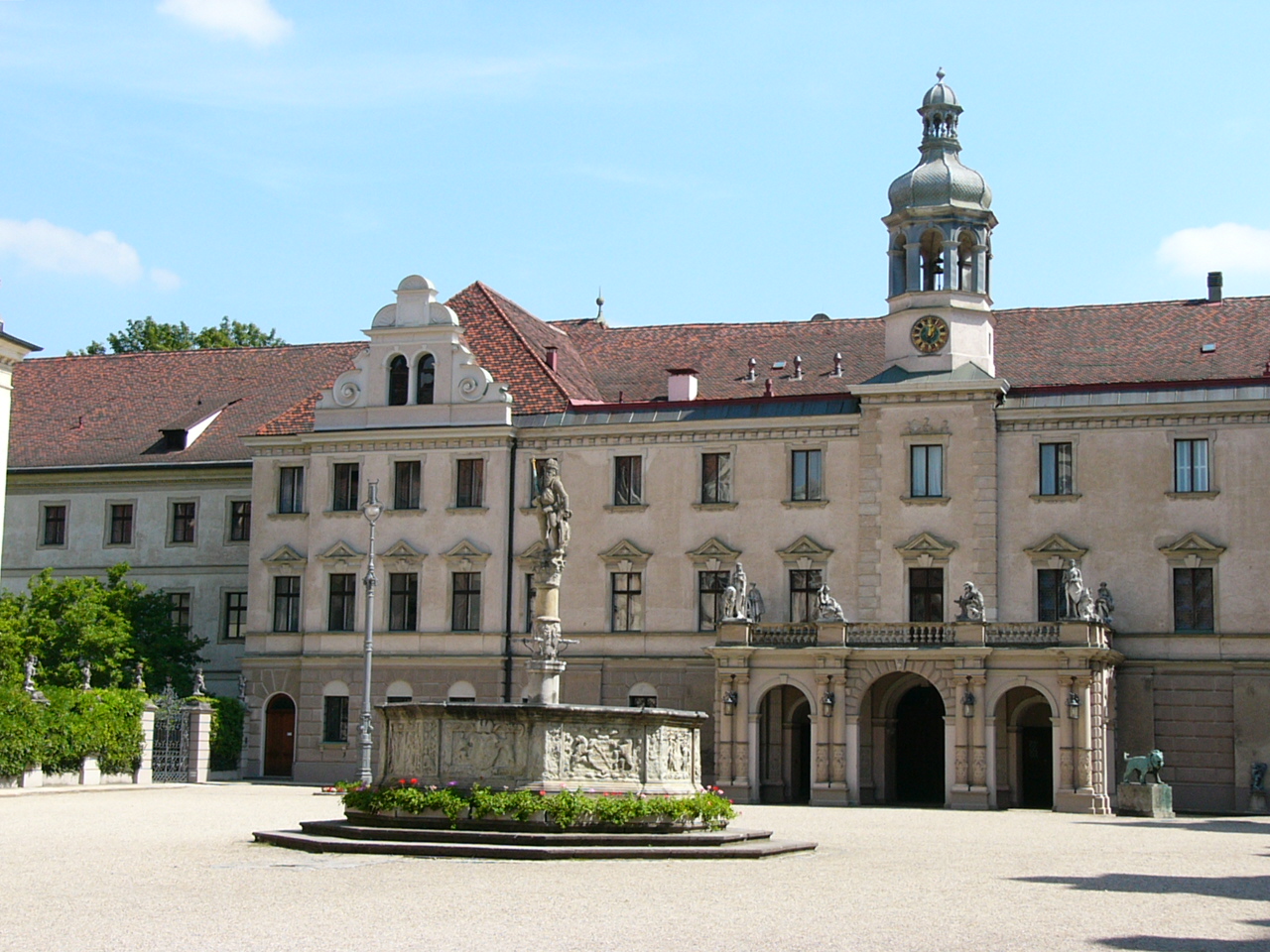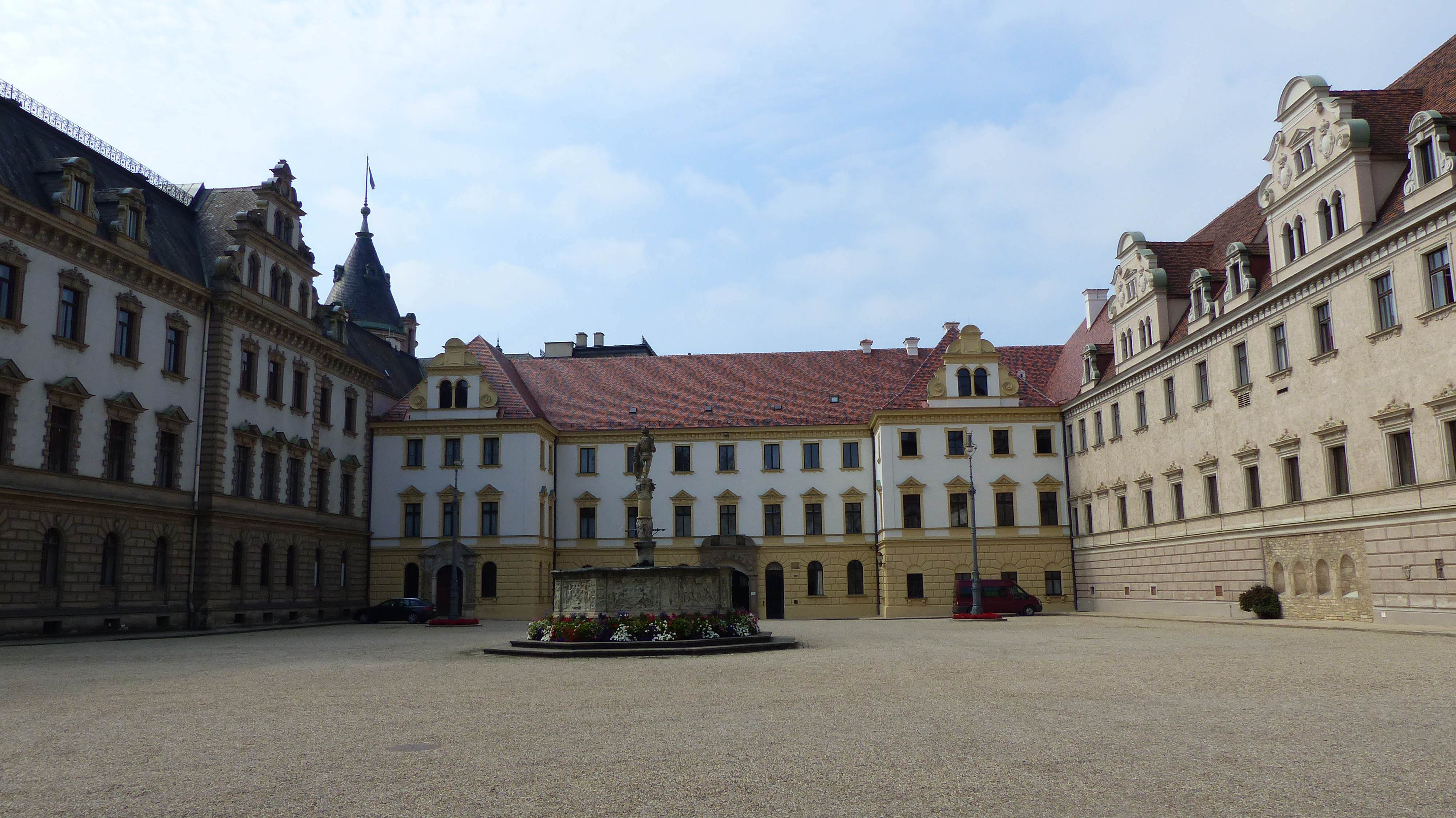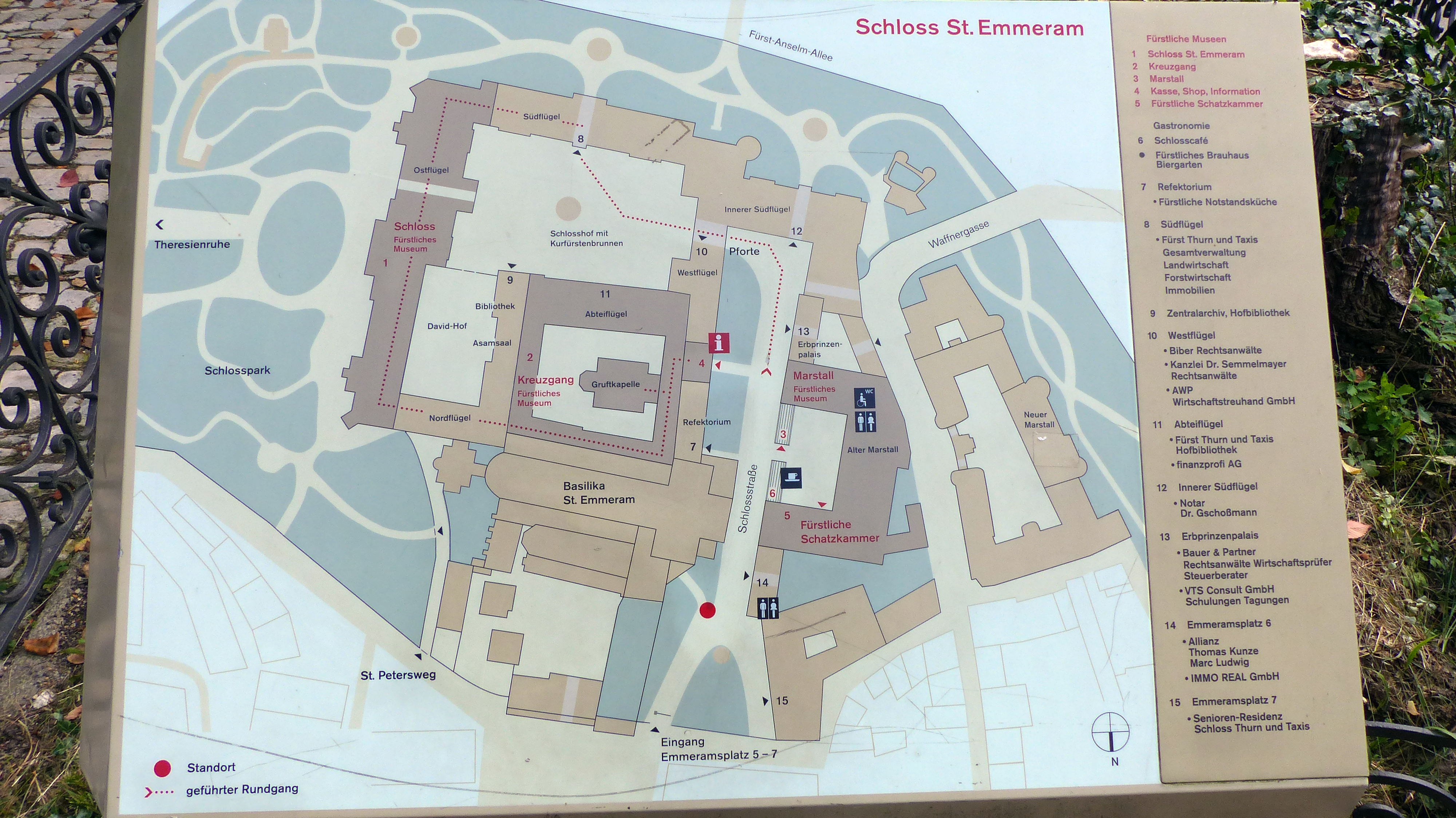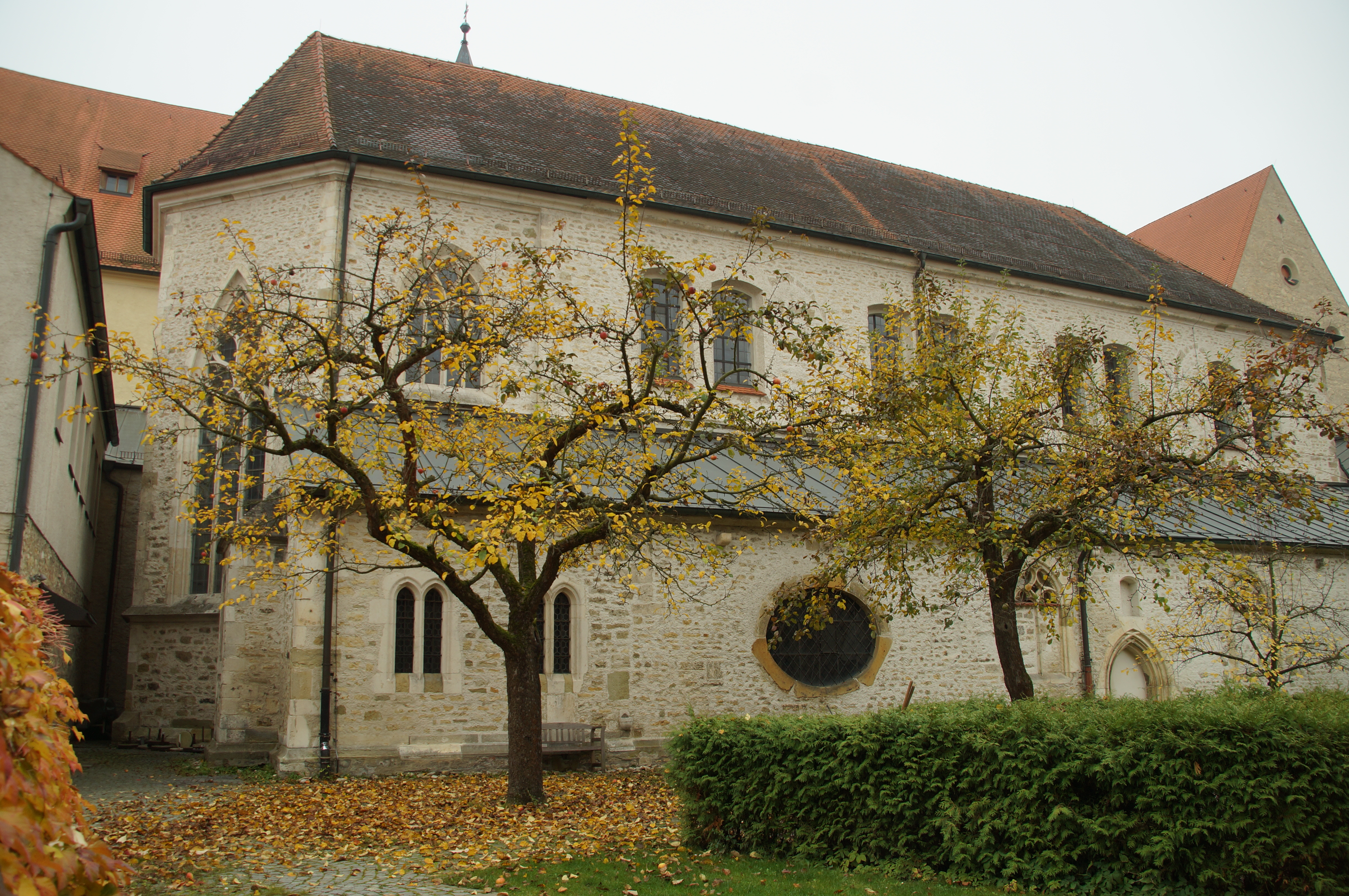Saint Emmeram's Abbey on:
[Wikipedia]
[Google]
[Amazon]


 Saint Emmeram's Abbey ( or ''Reichsabtei Sankt Emmeram'') was a
Saint Emmeram's Abbey ( or ''Reichsabtei Sankt Emmeram'') was a
 The abbey church became a parish church, to which
The abbey church became a parish church, to which Old church layout
( JPEG image) The Romanesque basilica with three aisles, three choirs and a west transept is based on an original church building from the second half of the 8th century. Since that time, it has been many times partly destroyed and rebuilt. The oldest extant part of the building is the ring crypt under the choir of the northern aisle. The three medieval, carved stone reliefs on the north portal, dating from about 1052, the oldest of their type in Germany, represent
2018 St. Emmeram 1.jpg, Central nave of the church and apse with high altar and two side altars
Regensburg St Emmeran Basilika 4.jpg, Large square pillars of the Ramwold church building from around 980/1000
St. Emmeram Regensburg Emmeramsplatz 4 D-3-62-000-350 06.jpg, Wolfgang Crypt in the west building (c. 1050)
St.Emmeram in Regensburg 5.jpg, Painted wooden ceiling depicting Saint
 St. Rupert's church was formerly the parish church of the monastery. The church, with two aisles, was constructed in the second half of the 11th century, but was frequently adapted and enlarged. The nave is from the 14th century, the choir from 1405, the high altar with four pillars and a picture of the baptism of Duke
St. Rupert's church was formerly the parish church of the monastery. The church, with two aisles, was constructed in the second half of the 11th century, but was frequently adapted and enlarged. The nave is from the 14th century, the choir from 1405, the high altar with four pillars and a picture of the baptism of Duke
Schloss Thurn und Taxis webpage
*
Bischöfliches Ordinariat Regensburg
*
Klöster in Bayern: Sankt Emmeram, Regensburg
*
(images) * ttps://web.archive.org/web/20101002113809/http://www.regensburg-entdecken.de/#/adressen/regensburg-entdecken/sehenswertes/kirchen/12009+6459-basilika-st-emmeram.html Virtual tour
Kreutzgang des Klosters in National-Archiv für Deutschlands Kunst und Alterthum, Nürnberg 1828
* Privileg Karls des Großen für Kloster St. Emmeram, 22.2.794, Basilica churches in Germany Bavarian Circle Benedictine monasteries in Germany Roman Catholic churches in Regensburg Castles in Bavaria Christian monasteries established in the 8th century Thurn und Taxis residences Imperial abbeys disestablished in 1802–03 Monasteries in Bavaria Palaces in Bavaria 8th-century establishments in Germany Burial sites of the House of Thurn und Taxis Burial sites of the Carolingian dynasty Burial sites of the Luitpoldings 739 establishments Churches completed in the 730s 8th-century churches in Germany {{coord, 49, 0, 55, N, 12, 5, 34, E, display=title, region:DE-BY_type:landmark_source:dewiki
Benedictine
The Benedictines, officially the Order of Saint Benedict (, abbreviated as O.S.B. or OSB), are a mainly contemplative monastic order of the Catholic Church for men and for women who follow the Rule of Saint Benedict. Initiated in 529, th ...
monastery founded around 739 at Regensburg
Regensburg (historically known in English as Ratisbon) is a city in eastern Bavaria, at the confluence of the rivers Danube, Naab and Regen (river), Regen, Danube's northernmost point. It is the capital of the Upper Palatinate subregion of the ...
in Bavaria
Bavaria, officially the Free State of Bavaria, is a States of Germany, state in the southeast of Germany. With an area of , it is the list of German states by area, largest German state by land area, comprising approximately 1/5 of the total l ...
(modern-day southeastern Germany
Germany, officially the Federal Republic of Germany, is a country in Central Europe. It lies between the Baltic Sea and the North Sea to the north and the Alps to the south. Its sixteen States of Germany, constituent states have a total popu ...
) at the grave of the itinerant Frankish
Frankish may refer to:
* Franks, a Germanic tribe and their culture
** Frankish language or its modern descendants, Franconian languages, a group of Low Germanic languages also commonly referred to as "Frankish" varieties
* Francia, a post-Roman ...
bishop Saint Emmeram. The original abbey church is now a parish church
A parish church (or parochial church) in Christianity is the Church (building), church which acts as the religious centre of a parish. In many parts of the world, especially in rural areas, the parish church may play a significant role in com ...
named St. Emmeram's Basilica. The other buildings on the site form a large complex known as Schloss Thurn und Taxis or Schloss St. Emmeram, which has served as the main residence of the Thurn und Taxis
The Princely House of Thurn and Taxis (, ) is a family of German nobility that is part of the ''Briefadel''. It was a key player in the mail, postal services in Europe during the 16th century, until the end of the Holy Roman Empire in 1806, and ...
princely family since the early 19th century.
History
When the monastery was founded in about 739, the bishops of Regensburg were abbots ''in commendam
In canon law, commenda (or ''in commendam'') was a form of transferring an ecclesiastical benefice ''in trust'' to the ''custody'' of a patron. The phrase ''in commendam'' was originally applied to the provisional occupation of an ecclesiastica ...
'', a common practice at the time which was not always to the advantage of the abbeys concerned. In 975, Saint Wolfgang of Regensburg
Wolfgang of Regensburg (; 934 – 31 October 994 AD) was bishop of Regensburg in Bavaria from Christmas 972 until his death. He is a saint in the Catholic and Eastern Orthodox churches. He is regarded as one of the three great German saints ...
, then bishop of Regensburg and abbot of St. Emmeram's, voluntarily gave up the position of abbot and severed the connection, making the abbots of St. Emmeram's independent of the bishopric. He was one of the first German bishops to do this, and his example in this was much copied across Germany in the years following. The first independent abbot was Ramwold (later the Blessed Ramwold). Both he and Saint Wolfgang were advocates of the monastic reforms of Gorze
Gorze (; ) is a commune in the Moselle department in Grand Est in north-eastern France.
Sites and monuments
Gorze Abbey was confiscated as public property during the French Revolution; it has since been restored and utilised for a variety of ...
.
Saint Wolfgang, who was made bishop in 972, ordered that a library be constructed at St. Emmeram shortly after his arrival in Regensburg. An active ''scriptorium'' had existed at St. Emmeram in the Carolingian period, but it is not known whether it occupied a special building, and it appears that relatively few manuscripts, of poor quality, were produced there during the early tenth century.Kyle, Joseph D. (1980). The Monastery Library at St. Emmeram (Regensburg). ''The Journal of Library History'', Vol. 15, No. 1 (Winter, 1980), pp. 1-21. University of Texas Press. Over time, some works in the ''scriptorium'' were copied by monks, some works were preserved from the Carolingian period, and others were acquired as gifts. The library became well supplied with works by early Christian writers such as Saint Augustine, as well as by ancient writers such as Virgil and Seneca. In addition to works that had an overt religious or inspirational purpose, the library held a large collection of manuscripts used in the monastery school, focusing on subjects such as logic, arithmetic, rhetoric, grammar, and even astronomy and music. By the early eleventh century, the library at St. Emmeram had acquired a reputation for its collection. Neighboring libraries began requesting to borrow books for copying. An eleventh-century librarian at the monastery, Froumund of Tegernsee, referred to the book room as a ''bibliotheca'', a term implying an extensive manuscript collection. St. Emmeram's ''scriptorium
A scriptorium () was a writing room in medieval European monasteries for the copying and illuminating of manuscripts by scribes.
The term has perhaps been over-used—only some monasteries had special rooms set aside for scribes. Often they ...
'' in the Early Middle Ages
The Early Middle Ages (or early medieval period), sometimes controversially referred to as the Dark Ages (historiography), Dark Ages, is typically regarded by historians as lasting from the late 5th to the 10th century. They marked the start o ...
became a significant centre of book production and illumination, the home of works such as the sacramentary
In the Western Christianity, Western Church of the Early Middle Ages, Early and High Middle Ages, a sacramentary was a book used for Christian liturgy, liturgical services and the Mass (liturgy), mass by a bishop or Priest#Christianity, priest. Sa ...
of Emperor Henry II (produced between 1002 and 1014) and the Uta Codex
The Uta Codex (Clm. 13601, Bavarian State Library, Munich) is a "gospel lectionary" or evangeliary. It contains those portions of the gospels which are read during church services. "Unlike most Gospel lectionaries, the individual readings in the ...
(shortly after 1002).
In 1295, the counter-king Adolf of Nassau granted the abbey the regalia
Regalia ( ) is the set of emblems, symbols, or paraphernalia indicative of royal status, as well as rights, prerogatives and privileges enjoyed by a sovereign, regardless of title. The word originally referred to the elaborate formal dress and ...
and made it '' reichsunmittelbar'' (i.e., an Imperial abbey
Princely abbeys (, ''Fürststift'') and Imperial abbeys (, ''Reichskloster'', ''Reichsstift'', ''Reichsgotthaus'') were religious establishments within the Holy Roman Empire which enjoyed the status of imperial immediacy (''Reichsunmittelbarke ...
, an independent sovereign power subject directly to the emperor
The word ''emperor'' (from , via ) can mean the male ruler of an empire. ''Empress'', the female equivalent, may indicate an emperor's wife (empress consort), mother/grandmother (empress dowager/grand empress dowager), or a woman who rules ...
).
After a decline in its significance during the 16th century, the abbey enjoyed a resurgence in the 17th and 18th centuries under abbots Frobenius Forster, Coelestin Steiglehner, Roman Zirngibl and Placidus Heinrich, who were great scholars, particularly in the natural sciences. Under their leadership, the abbey's academy came to rival the Münchner Akademie. St. Emmeram's had a long tradition of scientific enquiry dating from the Middle Ages, in witness of which the monastery preserved the astrolabe
An astrolabe (; ; ) is an astronomy, astronomical list of astronomical instruments, instrument dating to ancient times. It serves as a star chart and Model#Physical model, physical model of the visible celestial sphere, half-dome of the sky. It ...
of William of Hirsau.
In 1731, the abbots were raised to the status of Princes of the Empire ('' Reichsfürsten''). Between 1731 and 1733, there followed the magnificent Baroque
The Baroque ( , , ) is a Western Style (visual arts), style of Baroque architecture, architecture, Baroque music, music, Baroque dance, dance, Baroque painting, painting, Baroque sculpture, sculpture, poetry, and other arts that flourished from ...
refurbishment (by the Asam brothers) of the abbey church, which had been repeatedly burnt out and repaired.
In 1803, St. Emmeram's Abbey (along with the Imperial City of Regensburg, the Bishopric of Regensburg
The Prince-Bishopric of Regensburg () was a small ecclesiastical principality of the Holy Roman Empire located near the Free Imperial City of Regensburg in Bavaria. It was elevated to the Archbishopric of Regensburg in 1803 after the dissolu ...
and the two other Imperial abbeys, Niedermünster and Obermünster) lost its previous politically independent status to the newly formed Principality of Regensburg
The Principality of Regensburg () was a principality of the Holy Roman Empire that was created in 1803. Its capital was Regensburg. Following the dissolution of the Empire in 1806, the principality became a member state of the Confederation of ...
, often referred to as the Archbishopric of Regensburg, under the former Prince-Primate
Prince-primate ( German: ''Fürstprimas'', Hungarian: ''hercegprímás'') is a rare princely title held by individual (prince-) archbishops of specific sees in a presiding capacity in an august assembly of mainly secular princes, notably the fo ...
Carl Theodor von Dalberg. In 1803, he donated a large garden at the abbey to the Royal Bavarian Botanical Society of Regensburg for construction of a botanic garden that was maintained until 1855. After the Treaty of Paris of 1810, the entire Principality of Regensburg was transferred to Bavaria
Bavaria, officially the Free State of Bavaria, is a States of Germany, state in the southeast of Germany. With an area of , it is the list of German states by area, largest German state by land area, comprising approximately 1/5 of the total l ...
.
The treasures of St. Emmeram's Abbey (for example, the ciborium of Arnulf
Arnulf is a masculine German given name.
It is composed of the Germanic elements ''arn'' "eagle" and ''ulf'' "wolf".
The ''-ulf, -olf'' suffix was an extremely frequent element in Germanic onomastics and from an early time was perceived as a mere ...
, now in the Residenz
''Residenz'' () is a German word for "domicile", now obsolete except in the formal sense of an official residence. A related term, ''Residenzstadt'', denotes a city where a sovereign ruler resided, and thus carries a similar meaning to the contemp ...
) and its valuable library (including Muspilli
''Muspilli'' is an Old High German alliterative verse poem known in incomplete form (103 lines) from a ninth-century Bavarian manuscript. Its subject is the fate of the soul immediately after death and at the Last Judgment. Many aspects of the int ...
, the Codex Aureus of St. Emmeram, and ''Dialogus de laudibus sanctae crucis'') were mostly removed to Munich
Munich is the capital and most populous city of Bavaria, Germany. As of 30 November 2024, its population was 1,604,384, making it the third-largest city in Germany after Berlin and Hamburg. Munich is the largest city in Germany that is no ...
.
Schloss Thurn und Taxis
In 1812, thesecularized
In sociology, secularization () is a multilayered concept that generally denotes "a transition from a religious to a more worldly level." There are many types of secularization and most do not lead to atheism or irreligion, nor are they automatica ...
monastic buildings were granted to the Princes of Thurn und Taxis
The Princely House of Thurn and Taxis (, ) is a family of German nobility that is part of the ''Briefadel''. It was a key player in the mail, postal services in Europe during the 16th century, until the end of the Holy Roman Empire in 1806, and ...
, who converted the abbey into a palatial residence known from then on as Schloss Thurn und Taxis, also called Schloss St. Emmeram. It is the largest private residence in Germany, with 517 rooms and a floor area of 21,460 m2 (231,000 sq ft).
The residence with its park in Regensburg's city center covers five hectare
The hectare (; SI symbol: ha) is a non-SI metric unit of area equal to a square with 100-metre sides (1 hm2), that is, square metres (), and is primarily used in the measurement of land. There are 100 hectares in one square kilometre. ...
s. The Thurn und Taxis princely family still uses the ''Schloss
''Schloss'' (; pl. ''Schlösser''), formerly written ''Schloß'', is the German term for a building similar to a château, palace, or manor house.
Related terms appear in several Germanic languages. In the Scandinavian languages, the cogn ...
'' as its primary residence, thus it can be considered to be the family seat
A family seat, sometimes just called seat, is the principal residence of the landed gentry and aristocracy. The residence usually denotes the social, economic, political, or historic connection of the family within a given area. Some families t ...
.
St. Emmeram's Basilica
 The abbey church became a parish church, to which
The abbey church became a parish church, to which Pope Paul VI
Pope Paul VI (born Giovanni Battista Enrico Antonio Maria Montini; 26 September 18976 August 1978) was head of the Catholic Church and sovereign of the Vatican City State from 21 June 1963 until his death on 6 August 1978. Succeeding John XXII ...
accorded the status of a basilica minor on 18 February 1964.( JPEG image)
Christ
Jesus ( AD 30 or 33), also referred to as Jesus Christ, Jesus of Nazareth, and many other names and titles, was a 1st-century Jewish preacher and religious leader. He is the Jesus in Christianity, central figure of Christianity, the M ...
, Saint Emmeram and Saint Denis. The west transept has a painted wooden ceiling depicting Saint Benedict of Nursia
Benedict of Nursia (; ; 2 March 480 – 21 March 547), often known as Saint Benedict, was a Great Church, Christian monk. He is famed in the Catholic Church, the Eastern Orthodox Church, the Lutheran Churches, the Anglican Communion, and Old ...
. The crypt of Saint Wolfgang is beneath the choir of Saint Denis. Next to Saint Denis's altar in the northern aisle is the tomb of Emma, Queen of the East Franks (died 876), let into the wall. The high altar dates from 1669. The tower has six bells.
Benedict of Nursia
Benedict of Nursia (; ; 2 March 480 – 21 March 547), often known as Saint Benedict, was a Great Church, Christian monk. He is famed in the Catholic Church, the Eastern Orthodox Church, the Lutheran Churches, the Anglican Communion, and Old ...
Notable burials
* Saint Emmeram * Saint Wolfgang * Blessed Ramwold * Emma, Queen of the East Franks (consort ofLouis the German
Louis the German (German language, German: ''Ludwig der Deutsche''; c. 806/810 – 28 August 876), also known as Louis II of Germany (German language, German: ''Ludwig II. von Deutschland''), was the first king of East Francia, and ruled from 8 ...
)
* Blessed Aurelia, anchorite
In Christianity, an anchorite or anchoret (female: anchoress); () is someone who, for religious reasons, withdraws from secular society to be able to lead an intensely prayer-oriented, Asceticism , ascetic, or Eucharist-focused life. Anchorit ...
* The Blessed Bishops Wolflek, Gaubald and Tuto
* Arnulf of Carinthia
Arnulf of Carinthia ( – 8 December 899) was the duke of Carinthia who overthrew his uncle Emperor Charles the Fat to become the Carolingian king of East Francia from 887, the disputed king of Italy from 894, and the disputed Holy Roman Emperor, ...
, King of the East Franks and Holy Roman Emperor
* His son, King Louis the Child
Louis the Child (893 – 20/24 September 911), sometimes called Louis III or Louis IV, was the king of East Francia from 899 until his death and was also recognized as king of Lotharingia after 900. He was the last East Frankish ruler of the Car ...
* Arnulf the Wicked, Duke of Bavaria
The following is a list of monarchs during the history of Bavaria. Bavaria was ruled by several dukes and kings, partitioned and reunited, under several dynasties. Since 1918, Bavaria has been under a republican form of government, and from 19 ...
* Relics of Saints Maximianus and Calcidonius
* Johannes Aventinus, historian of Bavaria
* Engelberga, wife of Louis II, Holy Roman Emperor
Louis II (825 – 12 August 875), sometimes called the Younger, was the king of Italy and emperor of the Carolingian Empire from 844, co-ruling with his father Lothair I until 855, after which he ruled alone.
Louis's usual title was ''impera ...
St. Rupert's church
Theodo of Bavaria
Theodo (about 625 – 11 December c. 716), also known as Theodo V and Theodo II, was the Duke of Bavaria from 670 or, more probably, 680 to his death. It is with Theodo that the well-sourced history of Bavaria begins. He strengthened his duchy ...
by Saint Rupert from 1690, and the decoration and fittings from the 17th and 18th centuries. The tabernacle
According to the Hebrew Bible, the tabernacle (), also known as the Tent of the Congregation (, also Tent of Meeting), was the portable earthly dwelling of God used by the Israelites from the Exodus until the conquest of Canaan. Moses was instru ...
on the north side of the choir has figures of Saint Rupert and other saints. The altar of Saint Michael
Michael, also called Saint Michael the Archangel, Archangel Michael and Saint Michael the Taxiarch is an archangel and the warrior of God in Christianity, Judaism, and Islam. The earliest surviving mentions of his name are in third- and second- ...
dated from 1713. The nave is decorated with pictures of the miracles of Saint Rupert.
Abbots
Bishops of Regensburg (abbots ''ex officio'')
* Gaubald (739–761) * Sigerich (762–768) * Sintpert (768–791) * Adalwin (792–816) * Baturich (817–847) * Erchanfrid (c. 847–864) * Ambricho (c. 864–891) * Aspert (891–894) * Tuto (c. 894–930) * Isangrim (930–941) * Gunther (942) * Michael (c. 942–972) * Wolfgang (972–975)Abbots
Prince-Abbots
* Anselm Godin de Tampezo (1725–1742) * Johann V Baptist Kraus (1742–1762) * Frobenius Forster (1762–1791) * Coelestin II Steiglehner (1791–1803; died 1819)Notes
References
* Kallmünz, 1992. ''St. Emmeram in Regensburg. Geschichte - Kunst - Denkmalpflege.'' Thurn und Taxis-Studien 18. * Morsbach, P. (photos: A. Bunz), 1993: ''St. Emmeram zu Regensburg. Ehem. Benediktiner-Abteikirche.'' Großer Kunstführer Nr. 187. Schnell & Steiner: Regensburg. * ''1803 – Die gelehrten Mönche und das Ende einer 1000-jährigen Tradition.'' Exhibition guide. Bischöfliches Ordinariat Regensburg: Regensburg, 2003.External links
Schloss Thurn und Taxis webpage
*
Bischöfliches Ordinariat Regensburg
*
Klöster in Bayern: Sankt Emmeram, Regensburg
*
(images) * ttps://web.archive.org/web/20101002113809/http://www.regensburg-entdecken.de/#/adressen/regensburg-entdecken/sehenswertes/kirchen/12009+6459-basilika-st-emmeram.html Virtual tour
Kreutzgang des Klosters in National-Archiv für Deutschlands Kunst und Alterthum, Nürnberg 1828
* Privileg Karls des Großen für Kloster St. Emmeram, 22.2.794, Basilica churches in Germany Bavarian Circle Benedictine monasteries in Germany Roman Catholic churches in Regensburg Castles in Bavaria Christian monasteries established in the 8th century Thurn und Taxis residences Imperial abbeys disestablished in 1802–03 Monasteries in Bavaria Palaces in Bavaria 8th-century establishments in Germany Burial sites of the House of Thurn und Taxis Burial sites of the Carolingian dynasty Burial sites of the Luitpoldings 739 establishments Churches completed in the 730s 8th-century churches in Germany {{coord, 49, 0, 55, N, 12, 5, 34, E, display=title, region:DE-BY_type:landmark_source:dewiki